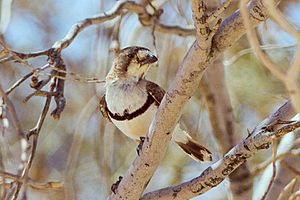Banded whiteface facts for kids
Quick facts for kids Banded whiteface |
|
|---|---|
 |
|
| Near Strzelecki Track, South Australia, Australia | |
| Conservation status | |
| Scientific classification | |
| Genus: |
Aphelocephala
|
| Species: |
nigricincta
|
| Synonyms | |
|
Xerophila nigricincta North |
|
The banded whiteface (Aphelocephala nigricincta) is a small bird that lives only in the dry parts of Australia. It belongs to a bird family called Acanthizidae.
This bird was first described in 1895 by a bird expert named Alfred John North. He called it Xerophila nigricincta. Later, another expert, Harry Church Oberholser, found that the name Xerophila was already used for a type of snail. So, in 1899, the bird got its current scientific name, Aphelocephala nigricincta.
Contents
What Does a Banded Whiteface Look Like?
The banded whiteface is a small bird, about 10 centimeters (4 inches) long. That's about the length of your hand!
Colors and Markings
- Its back and the top of its head are a grayish-brown color.
- It has a white mask on its face. This mask has a dark band that goes across its eyes.
- The upper part of its chest is a pale blue-gray.
- Its belly is white.
- A clear black band stretches across its chest, separating the pale blue-gray from the white. This is how it gets the "banded" part of its name!
- It also has reddish-brown patches on its sides.
- Its beak and legs are black, and its eyes are white.
Both male and female banded whitefaces look alike. Young birds, called juveniles, have duller colors than the adults.
How Does a Banded Whiteface Behave?
Like other birds in its group, the banded whiteface hops around on the ground. It often moves in pairs or small groups. They search for seeds and insects to eat.
Nesting Habits
Banded whitefaces usually build their nests in winter, from July to September. They might also nest after it rains.
- Their nests are built on the ground, usually near shrubs.
- The nest is round and hollow, made from twigs and grass.
- It has a long, tube-like entrance.
- Both the nest and the tunnel are lined with soft flowers and feathers.
Female banded whitefaces lay three or four eggs. The eggs are dull white with brown spots, mostly at the wider end. They are oval-shaped, about 17 millimeters long and 13 millimeters wide.
Sleeping Through the Cold
During cold winter nights, banded whitefaces have a special ability. They can enter a state called torpor. This is like a deep sleep where their body temperature and energy use drop very low. It helps them save energy when it's cold and food is scarce. They wake up as the morning gets warmer.
Where Do Banded Whitefaces Live?
The banded whiteface can be a nomadic bird, meaning it moves around, or it can stay in one place. It moves depending on the weather and seasons.
Habitat and Range
You can find this bird across a very large area of Australia.
- It lives in southwestern Queensland.
- It also lives in the dry central and southern parts of Australia.
- Its range extends into mid-Western Australia.
Banded whitefaces prefer certain types of environments:
- Mulga woodland: Areas with mulga trees.
- Gibber plains: Flat, stony deserts.
- Sandhills: Areas with sand dunes.
- They also like areas with saltbush and spinifex plants.
Images for kids
See also
 In Spanish: Aphelocephala nigricincta para niños
In Spanish: Aphelocephala nigricincta para niños



